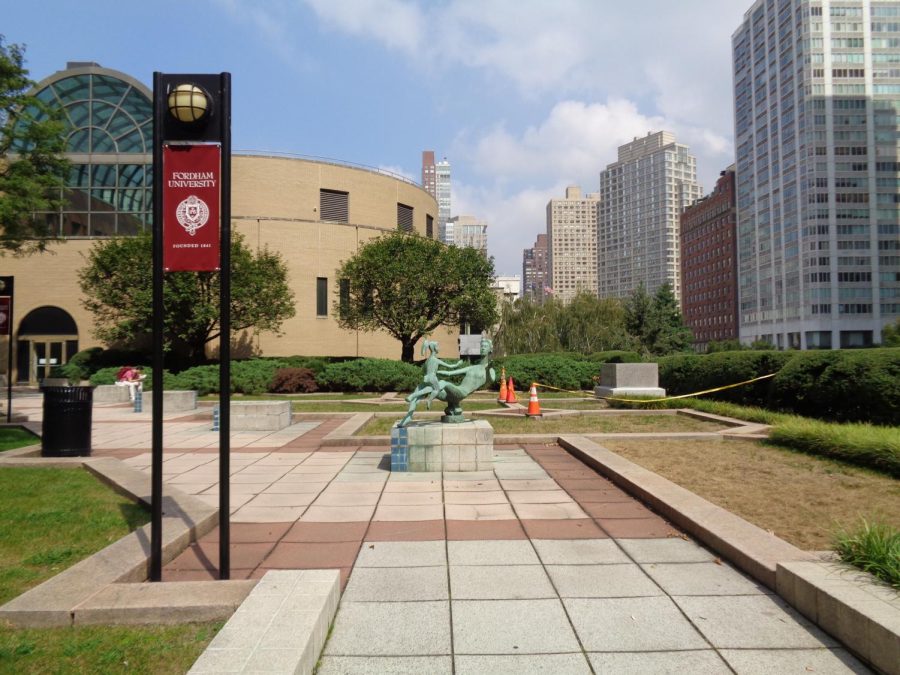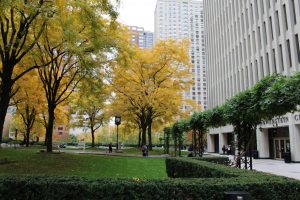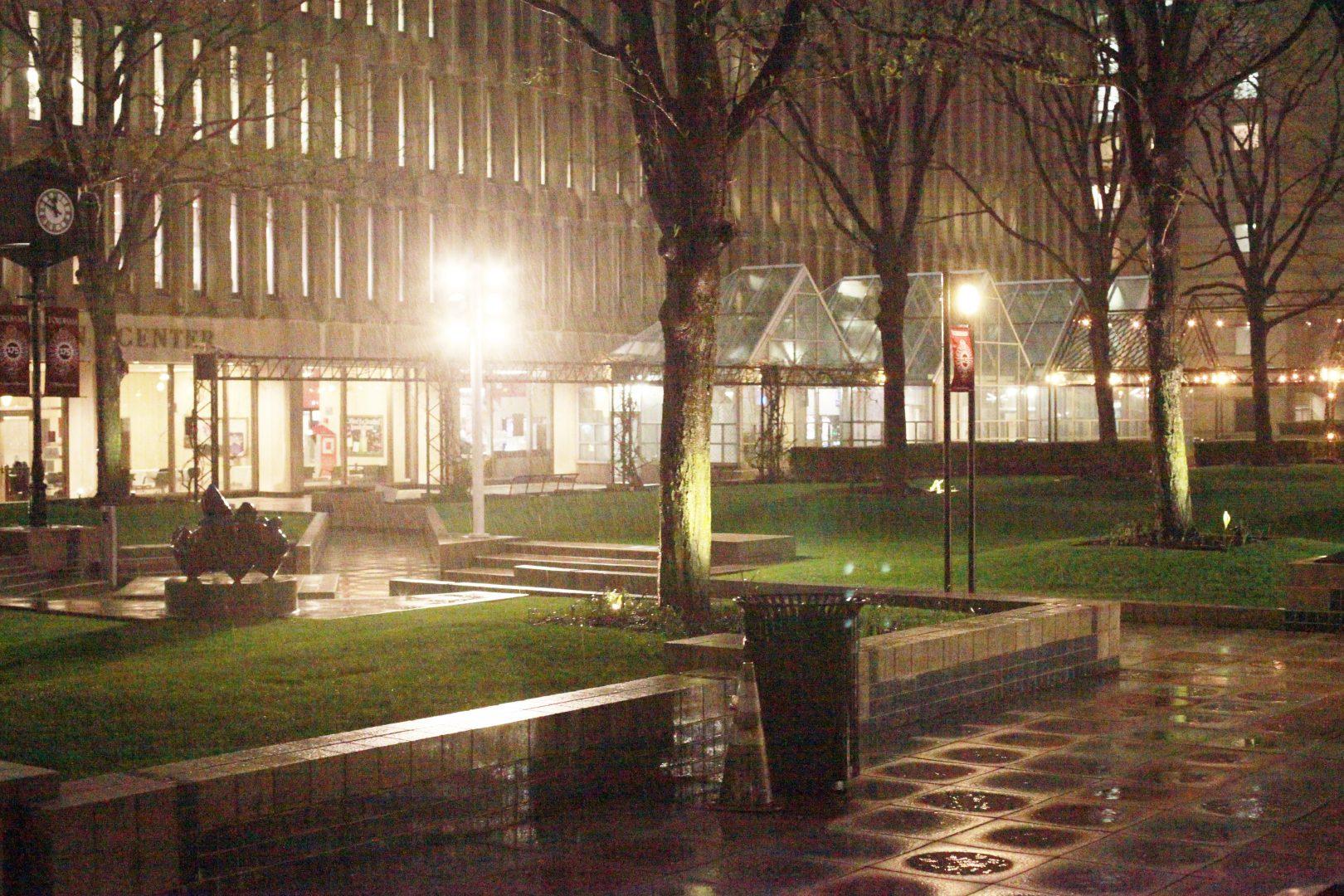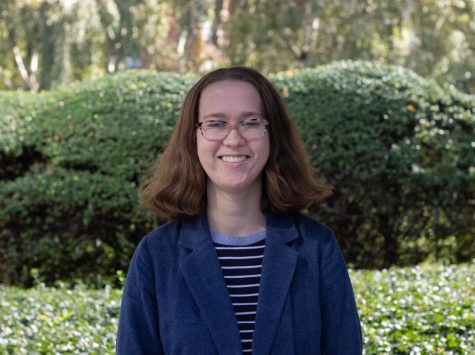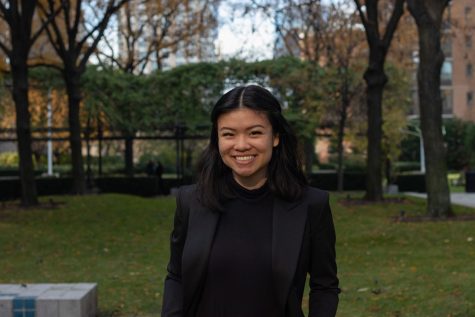A West Side Story: On the Birth of Fordham Lincoln Center
How we grapple with our past determines how we proceed with our future
The recently renamed Robert Moses Plaza signifies a deep history of Fordham’s displacement, which must be acknowledged and rectified.
May 16, 2022
To an average student, Fordham Lincoln Center, with its dated architecture and urban demeanor, appears ahistorical. It is as if the campus was born fully formed from the New York City grid. In some ways, this impression is true.
Fordham Lincoln Center was placed from the sky into Midtown Manhattan, bestowed by a higher entity. It was constructed as a part of the Lincoln Square Renewal Project, which saw the razing of the historically Black and Puerto Rican San Juan Hill neighborhood — and the construction of new homes for institutions such as the Metropolitan Opera, the New York City Library for the Performing Arts and The Juilliard School as a part of a master plan. The neighborhood had its struggles with poverty and crime but was by no means a hell on Earth. It was the home of Theolonius Monk and the birthplace of the Charleston dance. San Juan Hill was selected for the project less because of issues with the neighborhood than because of its proximity to Manhattan’s central business district. As the preliminary plans for the project note, the land was “far too valuable … to be permitted to remain as a blighted area of deterioration.”
Fordham’s inclusion in the project was particularly controversial, with detractors arguing that a city land subsidy — the land was seized through eminent domain and was sold to the university for next to nothing — violated the separation of Church and state because it was being sold to a Catholic institution. It was not a part of Fordham’s own master plan. The opportunity arose incidentally when then-University President Rev. Laurence McGinley, S.J., approached Robert Moses over renting a few floors in a building to be constructed at Columbus Circle. Moses turned down the request but asked McGinley if he was interested in an urban renewal project nearby.
“What is an urban renewal project?” McGinley replied to Moses, according to Fordham’s website. Moses countered by asking McGinley how many acres Fordham would want. The acres the Lincoln Square Renewal Project, one of Moses’ largest redevelopment projects, generated led to the forced displacement of upwards of 7,000 families and 800 businesses. Moses grabbed the land through eminent domain, which was possible as the New York City Housing Authority had declared San Juan Hill “one of the worst slums in New York City.” President Dwight D. Eisenhower attended the ground-breaking of the Lincoln Square Renewal Project in 1959. The Fordham Law School building opened first in 1961. Undergraduates were welcomed in 1968 to the Lincoln Center college, which was known as “The Liberal Arts College.”
Urban development is often presented as an exercise in Manichaeism, with the forces of good and bad dueling for control over city blocks. Since the publication of “The Power Broker,” Robert Caro’s devastatingly critical 1974 biography, Moses has loomed as a boogeyman over the field of urban planning. The venomous discussions that Moses brings are to the point where it’s difficult to convey the irony of being an urban studies student at a campus all but founded by him. It’s like studying diplomacy at a school created by Henry Kissinger or social welfare at a campus Margaret Thatcher built.
But there’s a fundamental difference between problematic figures of urban planning and those in other fields. Removing statues of Confederate generals, changing the name of Columbus Day or taking down portraits of Woodrow Wilson haven’t erased the memories of slavery, imperialism or colonialism from collegiate memory. But take your eyes off of the highway for long enough, and you’ll forget that you’re driving.
Without active reminders, the history of urban development and the reminder that the very spaces we inhabit are ideologized are too frequently lost.
Without active reminders, the history of urban development and the reminder that the very spaces we inhabit are ideologized are too frequently lost. For many decades, the Outdoor Plaza was officially known as the Robert Moses Plaza, and its center held a plinth commemorating Moses’ generosity towards Fordham. In 2016, the plaza’s name was quietly dropped and the plinth placed into storage (the plans to have it reinstalled with a plaque to provide context appear to have petered out) after several years of student activism. But by seeking to take down commemorations of Moses, we inadvertently contributed to the erasure of Moses’ role in Fordham Lincoln Center’s genesis.
Other Lincoln Square Renewal Projects have attempted to reckon with their history. In 2020, the Lincoln Center for the Performing Arts wrote that they are committed to telling “the story of Lincoln Center from our beginning, in its truth. The displacement of Indigenous, Black, and Latinx families that took place prior to the construction of our campus is abhorrent. We may never know its full impact on those dispossessed of the land on which Lincoln Center sits. But only by acknowledging this history can we begin to confront the racism from which our institution has benefited.”
In 2021, Jazz at Lincoln Center hosted the premiere of Steven Spielberg’s revival of “West Side Story.” The 1961 original was partially filmed in the San Juan Hill neighborhood, with debris from the neighborhood’s demolition seen in the background. By the time of the 2021 remake, the Lincoln Square Renewal Project took center stage. As the gangs skirmish, the police tell them that their conflict over neighborhood dominance is meaningless as soon their neighborhood will be obsolete.
These reintegrations of the legacy of the Lincoln Square Renewal project sit in contrast with Fordham’s own attempt to tell the story of Fordham Lincoln Center “in its truth.” Fordham’s website describes the Lincoln Square Renewal Project simply as “an effort to revitalize the city’s west side” and Moses as New York City’s “quintessential power broker.” References to San Juan Hill are elided. No references to the University’s history are contained within the university’s 2020 Diversity, Equity, and Inclusion plan. Rather than doing the work of confronting, contextualizing and acknowledging its past, the university seems content to let it slip into obsolescence. And with the removal of any references to Robert Moses on its property, the memory of the campus’ founding is hazy at best and purposely obscured at worst. And that’s a shame for a university that publicly commits itself to foster men and women for others.
I would be fascinated to see a new history written about Fordham’s involvement or a project dedicated to a real contextualization of who Moses was and how Fordham Lincoln Center’s story was physically molded by his efforts.
I don’t have a particular opinion on whether the university should keep the Robert Moses plinth. I would be remiss as an urban studies student to not acknowledge that recent years have seen the start of the recontextualization of Moses’ efforts to transform public life and amenities. The university has not exactly rushed to tell the story of its founding, but there’s plenty it could do. I would be fascinated to see a new history written about Fordham’s involvement or a project dedicated to a real contextualization of who Moses was and how Fordham Lincoln Center’s story was physically molded by his efforts.
But for right now, the Outdoor Plaza is a space built for an absence. All roads point to the former base of the plinth, but there is nothing and usually no one to be found. Over fifty years ago, there was a mob. At a July ceremony, University President Rev. Michael P. Walsh, S.J., and Governor Nelson Rockefeller baked in the summer sun as they dedicated the Moses plinth. It was a simple thing, reading only “Robert Moses, Masterbuilder, Friend of Fordham.” With red geraniums in view, they also announced that below their feet would be the Robert Moses Plaza. Rockefeller noted that no public works in the city bore Moses’ name and that it was fitting that Fordham be the first.
And Moses wept.

